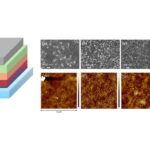
An international collaboration between scientists from Zhengzhou University in China and the University of South Australia has resulted in the development of an innovative bioplastic material, known as the bioplastic metafilm. This groundbreaking invention holds the promise of dramatically reducing energy consumption in urban environments without relying on electricity. As cities around the world grapple with rising temperatures and increased energy demands, the metafilm’s capabilities present a sustainable solution that could redefine how buildings manage heat.
At the core of the metafilm’s functionality is its ability to passively cool surfaces by lowering temperatures by as much as 9.2°C under peak sunlight conditions. This impressive performance is complemented by its ability to reflect nearly 99% of solar radiation, which is crucial for reducing heat absorption in buildings. The potential implications for energy savings are profound, with estimates suggesting that the metafilm could lead to annual energy consumption reductions of up to 20% in some of the hottest urban areas.
Researchers employed a fabrication technique involving polylactic acid (PLA), a plant-derived bioplastic, to create the metafilm. This innovative low-temperature process not only maximizes the film’s reflective properties—reportedly reflecting 98.7% of sunlight—but also enhances its sustainability as an alternative to traditional materials. Conventional cooling technologies often rely on electrically powered systems that are detrimental to the environment, making the metafilm a compelling choice for environmentally conscious building practices.
.adsslot_Bzw2yWdfXF{width:728px !important;height:90px !important;}
@media(max-width:1199px){ .adsslot_Bzw2yWdfXF{width:468px !important;height:60px !important;}
}
@media(max-width:767px){ .adsslot_Bzw2yWdfXF{width:320px !important;height:50px !important;}
}
ADVERTISEMENT
The cooling mechanisms of the metafilm extend beyond just reflecting sunlight. It allows heat generated within the building to escape into outer space, a critical feature that maintains a cooler internal environment compared to the surrounding air. This function is vital in mitigating the need for air conditioning systems, which are known contributors to carbon emissions and environmental degradation. By providing a passive cooling solution that operates without electricity, the metafilm represents a leap forward in sustainable architecture.
Field trials conducted in both Australia and China demonstrated the metafilm’s stability under extreme conditions. Throughout the day, the film was observed to cause an average temperature drop of 4.9°C, with similar cooling performance observed at night. This robust performance persisted even after prolonged exposure to acidic conditions and intense ultraviolet light, two factors that typically compromise the integrity of biodegradable materials. After enduring 120 hours in a strong acid environment and the equivalent of eight months under outdoor UV stress, the metafilm still exhibited its cooling capabilities effectively.
The invention addresses a critical challenge faced by researchers in the field of materials engineering: the need for high-performance cooling options that are also eco-friendly. As urban areas continue to expand and heat up, the reliance on traditional cooling methods increases carbon footprints and energy use. The introduction of the bioplastic metafilm offers a powerful alternative; one that not only aligns with sustainable development goals but also lays the groundwork for large-scale applications across various sectors.
Furthermore, the bioplastic metafilm stands out as a long-lasting solution that retains its effectiveness over time. The researchers involved have indicated that the material not only delivers high solar reflectance and thermal emission but also degrades naturally, thus minimizing environmental impact over its lifecycle. This characteristic sets it apart from existing cooling materials that often rely on petrochemical-based solutions, raising concerns about their ecological footprint.
In potential real-world applications, this revolutionary metafilm could extend beyond cooling buildings—it can have implications in various domains, including agriculture, transport, electronics, and even in health care through applications like cooling wound dressings. Explore the opportunities for scalable manufacturing, whether for public structures or private residences, and the impact this could have on reducing reliance on fossil fuels.
Experts involved in the creation of the metafilm, including UniSA PhD candidate Yangzhe Hou and co-author Dr. Xianhu Liu, emphasize the importance of this material in countering the challenges posed by climate change and urban heat. Their collaborative work highlights the successful blend of sustainability with cutting-edge science and engineering principles, focusing on a future where eco-friendly technologies play a critical role in building resilience against global warming.
As cities like Lhasa in China anticipate energy consumption reductions by as much as 20.3% with the use of this metafilm, the urgency for sustainable solutions has never been greater. Urban planners and engineers are urged to consider the integration of this bioplastic metafilm into future projects, as the demands for energy efficiency and resilience grow increasingly urgent.
The biological and environmental overhaul promised by this innovative metafilm showcases the capacity of scientific research to address pressing global challenges. It reinforces the message that sustainability and high-performance engineering can coexist, paving the way for a future where buildings not only provide shelter but also serve as active participants in the fight against climate change. The research team looks to pursue advanced applications, potentially revolutionizing how our built environment interacts with the planet.
With positive implications for urban energy consumption and ecological health, the bioplastic metafilm stands as a testament to the power of interdisciplinary collaboration in driving innovation. The journey from lab-scale experiments to practical applications is just beginning, and the research community remains optimistic about leveraging this technology for broader impact.
The study detailing this significant advancement in passive cooling technology is published in the journal Cell Reports Physical Science, contributing vital knowledge to the fields of engineering and environmental science. As researchers and engineers continue to seek viable solutions to the challenges of climate change, the bioplastic metafilm represents a beacon of hope for a sustainable future.
Subject of Research: Bioplastic metafilm for passive cooling
Article Title: A structural bioplastic metafilm for durable passive radiative cooling
News Publication Date: 24-Jun-2025
Web References: DOI: 10.1016/j.xcrp.2025.102664
References: Published in Cell Reports Physical Science
Image Credits: University of South Australia
Keywords
Materials engineering
Biomaterials
Sustainability
Sustainable development
Climate change mitigation
Tags: bioplastic metafilmClimate Change Solutionseco-friendly building innovationsenergy consumption reductionenergy-efficient constructioninnovative cooling solutionspassive cooling technologypolylactic acid applicationssolar radiation reflectionsustainable building materialsurban heat managementurban sustainability initiatives

